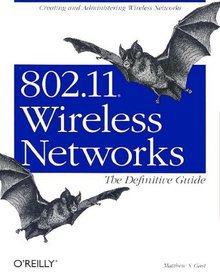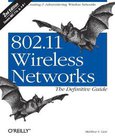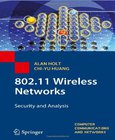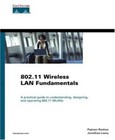802.11 Wireless Networks
The Definitive Guide

Book Details:
| Publisher: | O'Reilly Media |
| Series: | OReilly , The Definitive Guide |
| Author: | Matthew Gast |
| Edition: | 1 |
| ISBN-10: | 0596001835 |
| ISBN-13: | 9780596001834 |
| Pages: | 464 |
| Published: | Apr 01 2002 |
| Posted: | Nov 19 2014 |
| Language: | English |
| Book format: | |
| Book size: | 4.13 MB |
Book Description:
As a network administrator, architect, or security professional, you need to understand the capabilities, limitations, and risks associated with integrating wireless LAN technology into your current infrastructure. 802.11 Wireless Networks: The Definitive Guide provides all the information necessary to analyze and deploy wireless networks with confidence.Over the past five years, the world has become increasingly mobile. Traditional ways of networking have altered to accommodate new lifestyles and ways of working. Wireless networks offer several advantages over fixed (or wired) networks, with mobility, flexibility, ease and speed of deployment, and low-cost at the top of the list. Large productivity gains are possible when developers, students, and professionals are able to access data on the move. Ad-hoc meetings in the lunch room, library, or across the street in the caf allow you to develop ideas collaboratively and act on them right away. Wireless networks are typically very flexible, which can translate into rapid deployment. Once the infrastructure is in place, adding new users is just a matter of authorization.After a general introduction to wireless networks, this practical book moves quickly into the gory details of the 802.11 standard. If you ever need to debug a wireless network that isn't working properly, you'd better understand this material. 802.11 MAC (Media Access Control), detailed 802.11 framing, WEP (Wired Equivalent Privacy protocol), 802.1x, management operations, and the PCF (point coordination function) are all covered in detail. Author Matthew Gast also supplies impressive detail on the physical layers.As for getting a wireless network up and running... Gast offers clear, no-nonsense guide for using 802.11 on Windows and Linux, using and selecting access points, making deployment considerations, and seeing to 802.11 network monitoring and performance tuning. In the final section of the book, he summarizes the standardization work pending in the 802.11 working group.If you're looking for one book that provides a full spectrum view of 802.11, from the minute details of the specification, to deployment, monitoring, and troubleshooting, 802.11 Wireless Networks: The Definitive Guide is worth its weight in gold.
Book categories:
Software , Networking , Networks, Protocols & APIs , Wireless Networks , Telecommunications , 802.11Download Link:
Related Books:
802.11 Wireless Networks
The Definitive Guide
2nd Edition
As we all know by now, wireless networks offer many advantages over fixed (or wired) networks. Foremost on that list is mobility, since going wireless frees you from the tether of an Ethernet cable at a desk. But that's just the tip of the cable-free iceberg. Wireless networks are also more flexible, faster and easier for you to use, and more affordable to deploy and maintain.The de facto standard for wireless networking is the 802.11 protocol, which includes Wi-Fi (the wireless standard known as 802.11b) and its faster cousin, 802.11g. With easy-to-install 802.11 network hardware available everywhere you turn, the choice seems simple, and many people ...
802.11 Wireless Networks
Security and Analysis
Wireless communication has the advantage of mobility and obviates the need for cabling, but is inherently less secure and is subject to the heavy regulation of the radio frequency spectrum. Nevertheless, the allocation of unlicensed parts of the spectrum has facilitated the growth in wireless local area networks (WLANs). WLAN technology is progressing at a rapid pace, but the most widely accepted WLAN standard is the IEEE 802.11. This unique and highly practical text introduces the principles of WLANs based upon the IEEE 802.11 standards, demonstrating how to configure equipment in order to implement various network solutions. Readers will gain understanding of the security implications of wireless networks and learn how vulnerabilities can be mitiga...
802.11 Wireless LAN Fundamentals
Master the basics in designing, building, and managing a Cisco Aironet WLAN. Master the basics of Wireless LANs with this concise design and deployment guide Understand implementation issues for a variety of environments including vertical, SOHO, and enterprise networks Learn design and troubleshooting advice from real-world case studies 802.11 Wireless LAN Fundamentals gives networking engineers and IT professionals the knowledge they need to design, deploy, manage, and troubleshoot their own wireless local-area networks (WLANs). Starting with an overview of the technology and architecture of WLANs, the book goes on to explain services and advanced features that such applications can provide. Most importantly, it provides practical design guidance ...
2007 - 2021 © eBooks-IT.org



